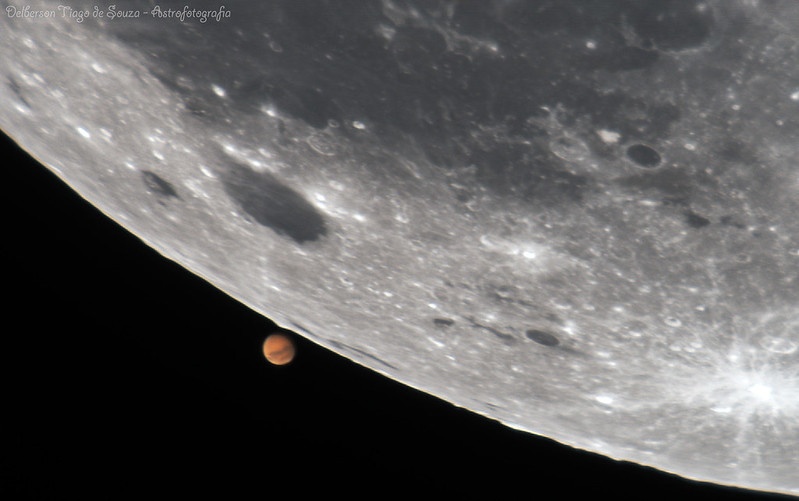A rare event transpires Wednesday night, as the Full Moon occults Mars near opposition.
Have you checked out Mars lately? The Red Planet currently rides high to the east at dusk, rising as the Sun sets. We call this opposition season, the biannual span when Mars passes closest to the Earth and offers observers optimal views of the planet. Mars opposition 2022 is special however, as three events converge in one night: Mars at opposition, the Moon reaches Full, and the Moon occults (passes in front of) Mars, all on the evening/morning of Wednesday/Thursday, December 7th/8th.
Celestial Dates with Destiny
You can see how the action around Mars stacks up in the first week of December:
1st- Mars passes nearest Earth (2:00 Universal Time/UT)
8th-Full Moon (4:00 UT)
8th-Mars Lunar Occultation (4:00 UT)
8th-Mars at Opposition (5:00 UT)
Note that Mars is closest to the Earth a week prior to opposition. This occurs for two reasons: while the Earth is moving towards perihelion in January (that is, we’re moving towards the Sun in December, but away from Mars), the Red Planet is doing the opposite, headed towards aphelion on May 30, 2023, just under six months after this week’s opposition. This makes up for the 900,000-odd kilometer difference as Mars is 0.55 Astronomical Units (AU, or 81.5 million kilometers) from Earth on the 1st, but sits 82.4 million kilometers from Earth at opposition.

In fact, we’re currently trending towards a cycle of unfavorable oppositions for Mars now, which will bottom out in February 2027 when Mars only reaches an apparent diameter of 13.8” as seen from the Earth. After 2027, Mars oppositions will slowly start to become more favorable again.
No Missions to Mars
Unfortunately, this Mars launch window also marks a sad milestone: for the first time since 2009, no mission will catch the biannual pre-opposition window to head to Mars. The European Space Agency’s ExoMars Rosalind Franklin rover was set to make the trip until Russia invaded Ukraine early this year, forcing ESA to look for another launch carrier and lander. ESA still hopes to get the rover to Mars by 2030.

‘Standing in the Shadow’ as the Moon occults Mars
But it’s Wednesday night’s occultation of Mars by the Full Moon that makes the 2022 opposition special. Opposition and the occultation plus the Full Moon all occur within an hour of each other. This is pretty rare: the near-Full Moon hasn’t occulted a naked eye planet or bright star since July 2019 (Saturn) and won’t do so again until May 24, 2024 (Antares), This is also the last of two occultations of Mars by the Moon for 2022, The Moon will occult Mars five times in 2023, though none are as favorable as the December’s event. The December ‘Long Night’s Moon’ nearest to the southward equinox also rides high in the sky for northern hemisphere observers, another plus.

This is also the closest Mars opposition versus a Full Moon with a lunar occultation for the 21st century. 21st century occultations of Mars near (less than 24 hours) from Full Moon also occur on December 24, 2007, January 14, 2025, February 5, 2042, May 28, 2048, February 27, 2059, and finally on April 27th 2078, which also features a shallow penumbral lunar eclipse.
The lunar occultation ‘footprint’ for Wednesday night’s occultation spans most of North America and Europe, with only the southeast U.S. missing out. Mars is 17” across during the event, shining at magnitude -1.9. The Moon will take just over half a minute to cover Mars during the occultation.

When to Watch
Here’s a table for select North American and European cities in the path of the occultation, with ingress/egress times. You can see an extensive list of sites and times here.
| City | Ingress | Egress |
| Detroit | 3:20UT/10:20PM EST | 4:09UT/11:09PM EST |
| Dallas | 2:54UT/8:54PM CST | 3:28UT/9:28PM CST |
| Los Angeles | 2:30UT/6:30PM PST | 3:30UT/7:30PM PST |
| Seattle | 2:51UT/6:51PM PST | 3:50UT/7:50PM PST |
| London | 5:00UT/5:00AM BST | 6:00UT/6:00 AM BST |
| Helsinki | 4:55UT/6:55AM EET | 5:39UT/7:39 AM EET |
Mars will be bright enough to follow riiiiiight up to the limb of the Full Moon during the event. The occultation occurs in the early morning hours for Europe on Thursday December 8th, and late in the evening of December 7th for North America. The disappearance of Mars behind the Moon will be visible even to the unaided eye, though binoculars or a small telescope will definitely help you enjoy the view.
Looking back from Mars, you’d be treated to an even stranger view, as the Moon transits the slim crescent Earth, just scant degrees from the Sun.

The Moon occults Mars: Weather Prospects, Watching Live
As of writing this, weather prospects for the contiguous United States (CONUS) look to favor the central northern states and the U.S. southwest.

Clouded out or simply live outside of the occultation footprint? Astronomer Gianluca Masi has you covered, with a live webcast as the Moon occults Mars, starting at 4:00 UT/11:00 PM EST Wednesday night.

The Moon Occults Mars: Spotting a ‘Daytime’ Red Planet
Finally… ever seen Mars in the daytime? It’s certainly possible near opposition… and the nearby Full Moon offers an excellent guide to complete this unusual feat of visual athletics. In North America, I’d start looking for Mars near the Moon just before local sunset, while in Europe, your best bet is to follow Mars near the Moon low to the West, after local sunrise.
Good luck, clear skies, and don’t miss this week’s unique, triple play dance of the Moon and Mars.

